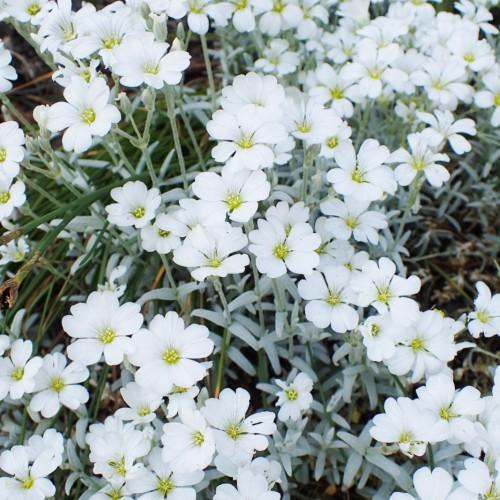
snow-in-summer
Cerastium tomentosum 'Yo Yo'
Also Known As - Dusty MillerCycle:
Herbaceous Perennial
Watering:
Minimum
Hardiness Zone:
3 - 7
Flowers:
Flowers
Sun:
full sun,part shade
Soil:
Rocky , gravelly , dry, Well-drained
Fruits:
Fruits Ready In Fall
Edible:
Yes
Leaf:
Yes
Growth Rate:
High
Maintenance:
Moderate
Drought Tolerant:
Yes
Salt Tolerant:
Yes
Care Level:
Easy
watering
Water Snow-in-Summer (Cerastium tometosum 'Yo Yo') when the soil becomes dry to the touch. A light weekly watering should be adequate for the plant, sufficient enough to moisten the root system. It is important to avoid overwatering or waterlogging as it can lead to nutrient deficiencies and other health issues. Additionally, consider using containers with drainage holes to prevent standing water from pooling in the soil. Additionally, during hot summer months the plants should be watered a bit more frequently.
sunlight
Snow-in-summer (Cerastium tomentosum 'Yo Yo') is a beautiful annual plant that grows well in full sun. For optimal growth and flowering, this particular species of plant should be placed in a location which receives at least 6-8 hours of direct sunlight each day. For best results, it is best to plant this species in a spot that enjoys morning sun and afternoon shade, but not complete shade. In areas where summers are especially hot, provide ample shade during the hottest part of the day (roughly noon to 3 pm). In regions where temperatures are milder, full sun exposure is best.
pruning
Snow-in-summer (Cerastium tomentosum 'Yo Yo') should be pruned in early spring, or just before spring. To promote flowering, simply cut back the flowering stems from the base to a few inches above the soil. You can also remove any dead or damaged leaves and stems at this time. Prune no lower than 1/4 inch above the surface of the soil. When the plant begins to become too large or out of shape, you can also trim it lightly. Make sure to keep an eye out for any dead or dying foliage during the growing season and prune them off as needed.
